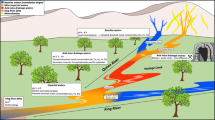Abstract
The influence of sources of effluents on pollution of bottom sediments of the small Chechło River (23 km long, mean discharge 1.5 m3 s–1) in southern Poland was examined through analysis of heavy metals distribution in transverse and longitudinal cross sections. Underground waters from a Pb–Zn mine cause very high concentrations of Zn, Cd, and Pb in both fractions investigated (<1 mm and <0.063 mm) of sediments in the active channel zone, whereas sedimentation of huge amounts of suspended matter discharged from oil refinery cause concentrations of heavy metals in fine fractions rather uniform in cross sections. In the lowest reach, with relatively reduced contamination, the highest concentration both in fine and coarse fractions occurs close to the river banks and in the deepest points of the channel. The lowest concentrations have been found at the points of strongest reworking and accumulation of sandy material in the riverbed.
Similar content being viewed by others
Author information
Authors and Affiliations
Additional information
Received: 25 April 1995 · Accepted: 11 September 1995
Rights and permissions
About this article
Cite this article
Ciszewski, D. Source of pollution as a factor controlling distribution of heavy metals in bottom sediments of Chechło River (south Poland). Environmental Geology 29, 50–57 (1997). https://doi.org/10.1007/s002540050103
Issue Date:
DOI: https://doi.org/10.1007/s002540050103




